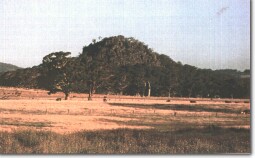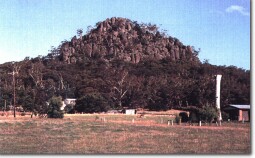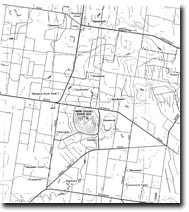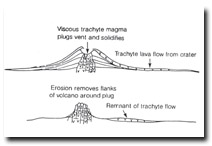Hanging Rock
|
This information has been obtained from the report: Eruption Points of the Newer Volcanic Province of Victoria by Neville Rosengren. This report was published in 1994 and was prepared for the National Trust of Australia (Victoria) and the Geological Society of Australia (Victorian Division). The review of eruption points was based on an earlier unpublished manuscript Catalogue of the post-Miocene volcanoes of Victoria compiled by O P Singleton and E B Joyce (Geology Department, University of Melbourne 1970). |
| Mt Diogenes, Dryden’s Rock. |  Hanging Rock | |
37 19 48S 144 35 42E (external link); 7823-3-4 (Woodend) 867656. 7 km NE of Woodend. Lancefield Road. South Rock Road. | ||
Newham and Woodend. | ||
Public land. | Forested, outcrop as cliffs. | |
Type 10: | Other eruption type (mamelon). | |
Hanging Rock is a volcanic eruption point that produced a small volume of soda-trachyte lava (silica rich) with little or no pyroclastic or fragmental material. Dating of Hanging Rock lava and that from adjacent similar eruption points indicate a Late Miocene age (about 6 million years). The lava is of a higher viscosity than most other Tertiary volcanoes in Victoria and its greater resistance to flow caused the growth of a dome or tholoid around the eruption point producing a steep-sided, fractured mass of lava rather than the thin sheets or flows resulting from the basaltic volcanoes. The structure is also known as namelon. Cooling of the rock produced numerous vertical features which shape the cliff faces and have been enlarged by weathering to produce a complex of pinnacles, craggy overhangs, small caverns and boulders on the slopes of Hanging Rock. | ||
711 m; 205 m. | ||
National: | Hanging Rock is an unusual volcano for Victoria both in terms of its form and rock composition. It lies along the time boundary between the Older Volcanics and Newer Volcanics series (Late Miocene) and results from a process of magma differentiation that is restricted to two small areas of the state (Gisborne/Woodend and Daylesford). The volcanoes of these areas constitute a distinctive, small volcanic province that has affinities with provinces in the Eastern Highlands in NSW and Queensland. The Victorian province is the westernmost and most recent of these. The site is an important teaching and reference site to illustrate the influence of lava type on volcano form and is the best example of its type in Victoria. Recent isotopic dating of the rock material has supported earlier (1930’s) scientific evaluation of the age and origin of the volcanic material. | |
References: | Skeats, E.W. & Summers, H.S. (1912). The geology and petrology of the Macedon district. Geological Survey of Victoria Bulletin 24. Edwards, A.B. (1938). The Tertiary volcanic rocks of central Victoria. Quarterly Journal of the Geological Society of London 94, pp. 243-320. Hills, E.S. (1940). The physiography of Victoria (1st edn,) Whitcombe & Tomba, Melbourne. Wellman, P. (1974). Potassium-argon ages on the Cainzoic volcanic rocks of eastern Victoria, Australia. Journal of the Geological Society of Australia 21, pp. 359-376. | |
 Hanging Rock | ||
 Hangin Rock 7823-3-4 (Woodend) |



